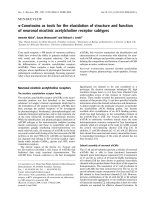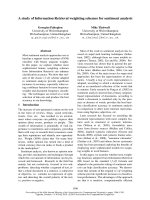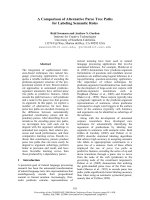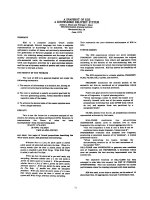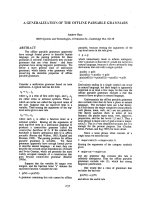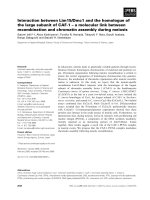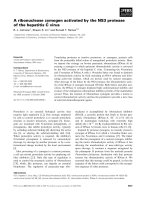Báo cáo khoa học: "A Theory of Parallelism and the Case of VP Ellipsis" pot
Bạn đang xem bản rút gọn của tài liệu. Xem và tải ngay bản đầy đủ của tài liệu tại đây (717.4 KB, 8 trang )
A Theory of Parallelism and the Case of VP Ellipsis
Jerry R. Hobbs and Andrew Kehler
Artificial Intelligence Center
SRI International
333 Ravenswood Avenue
Menlo Park, CA 94025
{hobbs, kehler}©ai, sri. com
Abstract
We provide a general account of parallelism
in discourse, and apply it to the special
case of resolving possible readings for in-
stances of VP ellipsis. We show how seyeral
problematic examples are accounted for in
a natural and straightforward fashion. The
generality of the approach makes it directly
applicable to a variety of other types of el-
lipsis and reference.
1 The Problem of VP Ellipsis
VP ellipsis has received a great deal of atten-
tion in theoretical and computational linguistics
(Asher, 1993; Crouch, 1995; Dalrymple, Shieber,
and Pereira, 1991; Fiengo and May, 1994; Gawron
and Peters, 1990; Hardt, 1992; Kehler, 1993; Lappin
and McCord, 1990; Priist, 1992; Sag, 1976; Web-
bet, 1978; Williams, 1977, inter alia). The area is
a tangled thicket of examples in which readings are
mysteriously missing and small changes reverse judg-
ments. It is a prime example of a phenomenon at
the boundary between syntax and pragmatics.
VP ellipsis is exemplified in sentence (1).
(1) John revised his paper before the teacher did.
This sentence has two readings, one in which the
teacher revised John's paper (the
strict
reading), and
one in which the teacher revised his own paper (the
sloppy
reading). Obtaining an adequate account of
strict/sloppy ambiguities has been a major focus of
VP ellipsis research. This is challenging because not
all examples are as simple as sentence (1). In fact,
sentence (1) is the first main clause of one of the
more problematic cases in the literature:
(2) John revised his paper before the teacher did,
and Bill did too.
Whereas one might expect there to be as many as
six readings for this sentence, Dalrymple et ai. (1991,
henceforth DSP) note that it has only five readings;
the reading is absent in which
(3) John revised John's paper before the teacher
revised John's paper, and Bill revised John's
paper before the teacher revised Bill's paper.
Previous analyses have either generated too few or
too many readings, or have required an appeal to
additional processes or constraints external to the
actual resolution process itself.
Examples like (2) test the adequacy of an analysis
at a fine-grained level of detail. Other examples test
the generality of an analysis, in terms of its ability
to account for phenomena similar to VP ellipsis and
to interact with other interpretation processes that
may come into play. For instance, strict/sloppy am-
biguities are not restricted to VP ellipsis, but are
common to a wide range of constructions that rely
on parallelism between two eventualities, some of
which are listed in Table 1. Given the ubiquity
of strict/sloppy ambiguities, one would expect these
to be a by-product of general discourse resolution
mechanisms and not mechanisms specific to VP el-
lipsis. Any account applying only to the latter would
miss an important generalization.
In this paper, we give an account of resolution
rooted in a general computational theory of paral-
lelism. We demonstrate the depth of our approach
by showing that unlike previous approaches, the al-
gorithm generates the correct five readings for ex-
ample (2) without appeal to additional mechanisms
or constraints. We also discuss how other 'missing
readings' cases are accounted for. We show the gen-
erality of the approach by demonstrating its han-
dling of several other examples that prove prob-
lematic for past approaches, including a
source-of-
ellipsis paradox,
so-called
extended parallelism
cases,
and
sloppy readings with events
cases. Of the phe-
394
Phenomenon Example
'Do It' Anaphora
'Do So' Anaphora
Stripping
Comparative Deletion
'Same As' Reference
'Me Too' Phenomena
'one' Anaphora
Lazy Pronouns
Anaphoric Deaccenting
Focus Phenomena
John revised his paper before Bill did it.
John revised his paper and Bill did so too.
John revised his paper, and Bill too.
John revised his paper more quickly' than Bill.
John revised his paper, and Bill did the same.
John revised his paper, and the teacher followed suit.
A: John revised his paper.
B: Me too./Ditto.
John revised a paper of his, and Bill revised one too.
The student who revised his paper did better than
the student who handed it in as is.
John said he called his teacher an idiot,
and Bill
said he insulted his teacher
too.
Only John revised his paper.
Table 1: Phenomena Giving Rise to Sloppy Interpretations
nomena in Table 1, we briefly discuss the algorithm's
handling of
lazy pronoun
cases.
2 A Theory of Parallelism
The Theory A clause conveys a property or even-
tuality, or describes a situation, or expresses a
proposition. We use the term "property" to cover
all of these cases. A property consists of a predi-
cate applied to a number of arguments. We make
use of a duality between properties having a number
of arguments, and arguments having a number of
properties. Parallelism is characterized in terms of
a co-recursion in which the similarity of properties is
defined in terms of the similarity of arguments, and
the similarity of arguments is defined in terms of the
similarity of properties. 1
Two fragments of discourse stand in a parallel re-
lation if they describe similar properties. Two prop-
erties are similar if two corresponding properties can
be inferred from them in which the predicates are the
same and the corresponding pairs of arguments are
either coreferential or similar.
Similarly(el,x1,
•, Zl),
p2(e2;
x2, , z2)]:
p~(el,xl, ,Zx)
~ p'(el,xl, ,zl)
and
I
e
, ,
P2(
2,X2,
Z2)
Dp'(e2,x2,
z2), where
Corer(x1, , x2 )
or
Similar[x1, x2],
Corer(z1, , z2, . . .)
or
Similar[z1,
z2]
Two arguments are similar if their other, "inferen-
tially independent" properties are similar.
Similar[xl,
x2]:
Similar~ ( , zl, . . .),p~2 ( , x2, . . .)],
Similar[q~ ( , Xl , . . .), q~ ( , x2, . . .)]
1This account is a elaboration of treatments of par-
allelism by Hobbs (1979; 1985) and Kehler (1995).
The constructed mapping between pairs of argu-
ments must be preserved and remain one-to-one.
There are three ways the recursion can bottom
out. we can run out of new arguments in prop-
erties. We can run out of new, inferentially inde-
pendent properties of arguments. And we can "bail
out" of proving similarity by proving or assuming
coreference between the two entities.
Two properties are
inferentially independent
if
neither can be derived from the other. Given a
knowledge base K representing the mutual knowl-
edge of the participants in the discourse, properties
P1 and P2 are inferentially independent if neither
K,/)1 I P~ nor K, P2 ~- PI. This rules out the case
in which, for example, the fact that John and Bill
are both persons would be used to establish their
similarity when the fact that they are both men
has already been used. Inferential independence is
generally undecidable, but in practice this is not a
problem. In discourse interpretation, all we usually
know about an entity is the small set of properties
presented explicitly in the text itself. We may take
these to be inferentially independent and look for no
further properties, once properties inferrable from
these have been used in establishing the parallelism.
Similarity is a matter of degree. The more corre-
sponding pairs of inferentially independent proper-
ties that are found, and the more contextually salient
those properties are, the stronger the similarity. In
a system which assigns different costs to proofs (e.g.,
Hobbs et al. (1993)), the more costly the proofs re-
quired to establish similarity are, the less similar the
properties or arguments should seem. Interpreta-
tions should seek to maximize similarity.
This account of parallelism is semantic in the sense
that it depends on the content of the discourse rather
than directly on its form. But syntax plays an im-
plicit role. When seeking to establish the paral-
395
lelism between two clauses, we must begin with the
"top-level" properties; this is generally determined
by the syntactic structure of the clause. Then the
co-recursion through the arguments and properties
normally mirrors the syntactic structure of the sen-
tence. However, features of syntax that are not man-
ifested in logical form are not taken into account.
An Example To illustrate that the theory has
applicability well beyond the problem of VP ellip-
sis, we present an example of semantic parallelism
in discourse. It comes from an elementary physics
textbook, and is worked out in essentially the same
manner in Hobbs (1979).
(4) A ladder weighs 100 lb with its center of grav-
ity 10 ft from the foot, and a 150 lb man is
10 ft from the top.
We will assume "the foot" has been identified as the
foot of the ladder. Because it is a physics problem,
we must reduce the two clauses to statements about
forces acting on objects with magnitudes in a direc-
tion at a point in the object:
force(w1, L, dl,
zl);
force(w2, y, d2, x2)
In the second clause we do not know that the man
is standing on the ladder he could be on the roof
and we do not know what "the top" is the top of.
These facts fall out of recognizing the parallelism.
The procedure for establishing parallelism is il-
lustrated in Figure 1, in which parallel elements are
placed on the same line. The
force
predicates are the
same so there is no need to infer further properties.
The first pair of arguments, wl and w2 are similar in
that both are weights. To make the second pair of
arguments similar, we can assume they are corefer-
ential; as a by-product, this tells us that the object
the man's weight is acting on is the ladder, and hence
that the man is on the ladder. The third pair of argu-
ments are both downward directions. The final pair
of arguments, x~ and x2, are similar if their proper-
ties
distance(x1, f,
20ft) and
distance(x2, t,
10ft) are
similar. These will be similar if their previously un-
matched pair of arguments f and t are similar. This
holds if their properties
foot(f, L)
and
top(t, z)
are
similar. We infer
end(f, L) and end(t, z ),
since feet
and tops are ends. Finally, we have to show L and
z are similar. We can do this by assuming they are
coreferential. This, as a by-product, tells us that the
top is the top of the ladder.
The use of inferences, such as '% foot is an end",
means that this theory is parametric on a knowl-
edge base. Different sets of beliefs can yield different
bases for parallelism and indeed different judgments
about whether parallelism occurs at all.
A crucial piece of our treatment of VP-ellipsis is
the explicit representation of coreference relations,
denoted with the predicate
Core].
We could use
equalities such as y = L, or since equals can be re-
placed by equals, simply replace y with L. However,
doing this would lose the distinction between y and
L under their corresponding descriptions.
Consequently, we introduce the relation
Corer(y,
e~, x, el) to express this coreferentiality.
This relation says that y under the description as-
sociated with e2 is coreferential with x under the
description associated with el. From this we can in-
fer y = x but not e2
=
el, and the coreferentiality
cannot be washed out in substitution. A constraint
on the arguments of
Corefis
that el and e2 be prop-
erties of x and y respectively.
The phenomenon of parallelism pervades dis-
course. In addition to straightforward examples of
parallelism like the above, there are also contrasts,
exemplifications, and generalizations, which are de-
fined in a similar manner. The interpretation of a
number of syntactic constructions depends on recog-
nizing parallelism, including those cited in Table 1.
In brief, our theory of parallelism is not something
we have introduced merely for the purpose of han-
dling VP ellipsis; it is needed for a wide range of
sentential and discourse phenomena.
Other Approaches
Based on Parallelism Our
aim in this paper is to present the theory of paral-
lelism at an abstract enough level that it can be em-
bedded in any sufficiently powerful framework. By
"sufficiently powerful" we mean that there must be
a formalization of the notion of inference, strength
of inference, and inferential independence, and there
must be a reasonable knowledge base. In Hobbs and
Kehler (forthcoming), we show how our approach
can be realized within the "Interpretation as Ab-
duction" framework (Hobbs et al., 1993).
There are at least two other treatments in which
VP ellipsis is resolved through a more general system
of determining discourse parallelism, namely, those
of PriJst (1992) and Asher (1993).
Prfist (1992) gives an account of parallelism devel-
oped within the context of the Linguistic Discourse
Model theory (Scha and Polanyi, 1988). Parallelism
is computed by determining the "Most Specific Com-
mon Denominator" of a set of representations, which
results from unifying the unifiable aspects of those
representations and generalizing over the others. VP
ellipsis is resolved as a side effect of this unifica-
tion. The representations assumed, called
syntac-
396
f orce(wl , L, dl, xl )
wl : lb(wl,
100)
L : ladder(L)
dl : Down(dl)
xz : distance(xt, f,
20ft)
f: foot(f, L) =~ end(f, L)
L:
force(w2, y, d~., z~.)
w2 : lb(w2,150)
y :~ Coref(y, , L, )
d2 :Down(d2)
x2 : distance(x2, t,
10ft)
t : top(t, z) ~ end(t, z)
z :~ Coref(z, , L, )
Figure 1: Example of Parallelism Establishment
tic/semantic structures,
incorporate both syntactic
and semantic information about an utterance. One
weakness of this approach is that it appears overly
restrictive in the syntactic similarity that it requires.
Asher (1993) also provides an analysis of VP ellip-
sis in the context of a theory of discourse structure
and coherence, using an extension of Discourse Rep-
resentation Theory. The resolution of VP ellipsis
is driven by a need to maximize parallelism (or in
some cases, contrast) that is very much in the spirit
of what we present.
Detailed comparisons with our approach are given
with the examples below. In general, however, in
neither of these approaches has enough attention
been paid to other interacting phenomena to explain
the facts at the level of detail that we do.
3 VP Ellipsis: A Simple Case
We first illustrate our approach on the simple case
of VP ellipsis in sentence (1). The representation
for the antecedent clause in our "logical form" ~ ap-
pears on the left-hand side of Figure 2. Note that
a Core]
relation links Xl, the variable corresponding
to "he" (eventuality e13), to its antecedent j; the
entity described by "John" (eventuality ell).
From the second clause we know there is an elided
eventuality e22 of unknown type P, the logical sub-
ject of which is the teacher t.
P(e22, t)
t : teachert(e21, t)
Because of the ellipsis, e22 must stand in a parallel
relation to some previous eventuality; here the only
candidate is John's revising his paper (e12). To es-
tablish
Similar(el2,
e22),3 we need to show that their
corresponding arguments are similar. John j and the
2The normally controversial term "logical form" is
used loosely here, simply to capture the information that
the hearer must bear in mind, at least implicitly, in in-
terpreting texts such as sentence (1).
3 We cannot establish coreference between the events
because their agents are distinct. In other cases, how-
ever, the process can bail out immediately in event coref-
erence; consider the sentence "John revised his paper,
teacher t are similar by virtue of being persons. The
corresponding objects Pl and/>2 are similar if we take
p2 to be a paper and to have a
Poss
property similar
to that of Pl. The latter is true if corresponding to
the possessor Xl, there is an x2 that is similar to xl.
In constructing the similarity between x2 and xl,
we can either take them to be coreferential (case *a)
or prove them to be similar by having similar prop-
erties, including having similar dependencies estab.
lished by
Core]
(case *b). In the former case, x~ is
coreferential with xl which is coreferential with John
j, giving us the strict reading. In the latter case, we
must preserve the previously-constructed mapping
between John j (on which xl is dependent) and the
teacher t; thus x2 is similar to xl if taken to be
coreferential with t, giving us the sloppy reading. 4
4 A Missing Readings Paradox
Sentence (1) is the antecedent clause for example
(2), one of the more problematic examples in the
literature. Theoretically, this example could have as
many as six readings, paraphrased as follows:
(5) John revised John's paper before the teacher
revised John's paper, and Bill revised
John's/Bill's paper before the teacher revised
John's/Bill's paper.
(6) John revised John's paper before the teacher
revised the teacher's paper, and Bill revised
John's/Bill's paper before the teacher revised
the teacher's paper.
smoking incessantly as he did." A
Core]
link is estab-
lished between the elided and antecedent events in the
same way as for pronouns. This symmetry accounts for
another problematic case, discussed in Section 6.
4It is also possible to "bail out" in coreference be-
tween the papers pl and p2; here we would get the strict
reading again. However, consider if the example had said
"a paper of his" rather than "his paper". The resulting
sentence has two strict readings, one in which both re-
vised the same paper of John's (generated by assuming
coreference between the papers), and one in which each
revised a (possibly) different paper of John's (generated
by assuming coreference between the pronouns).
397
before'(el2,
e22)
revise'(e12, j, Pl)
j: John'(ell,j)
Pl : paper'(els,pl)
Poss'(e14, xl,pl)
xl : he'(e13,xl)
Coref(xl,
el3, j, ell)
revise'(e22, t,
P2)
t : teacher'(e21, t)
P2 : papert(e25, P2)
Poss'
(e24, x2, P2)
x2 : he'(e23,x2)
[Co~ef(z~., e23, xl,
e13) (*a)]
[Corel(z2,
e23,
t, e ,~) (*b)]
Figure 2: Representations for Simple Case
We follow DSP in claiming that this example has five
readings, in which the JJJB reading shown in (3) is
missing. ~ DSP, who use this case as a benchmark
for theories of VP ellipsis, note that the methods of
Sag (1976) and Williams (1977) can be seen to derive
two readings, namely JJJJ and JTBT. An analysis
proposed by Gawron and Peters (1990), who first
introduced this example, generates three readings
(adding JJBB to the above two), as does the analysis
of Fiengo and May (1994). A method that Gawron
and Peters attribute to Hans Kamp generates either
four readings, including the above three and JTJT,
or all six readings. DSP's analysis strictly speak-
ing generates all six readings; however, they appeal
to anaphor/antecedent linking relationships to elim-
inate the JJJB reading. However, these linking rela-
tionships are not a by-product of the resolution pro-
cess itself, but must be generated separately. Our
approach derives exactly the correct five readings. 6
The antecedent clause is represented in Figure 2,
and the expansion of the final VP ellipsis is shown
in Figure 3. In proving similarity, each pronoun can
be taken to be coreferential with its parallel element
(cases *a, *c and *e), or proven similar to it (cases
*b, *d, *f and *g). If choice *a is taken in the sec-
ond clause, then the "similarity" choice in the fourth
clause must be *f; if *b, then *g. If *a and *c are
chosen, the JJJJ reading results. If *a, *d, and *e
are chosen, the JJBJ reading results. If *a, *d, and
*f are chosen, the JJBB reading results. If *b and *c
are chosen, the JTJT reading results. If *b and *d
are chosen, the JTBT reading results. Thus taking
all possible choices gives us all acceptable readings.
Now consider what it would take to obtain the
*JJJB reading. The variable x3 would have to be
5Each reading for this example contains four descrip-
tions of papers that were revised. We use the notation
JJJB to represent the reading in which the first three
papers are John's and fourth is Bill's, corresponding to
reading (3). Other uses of such notation should be un-
derstood analogously.
6The approach presented in Kehler (1993) also derives
the correct five readings, however, our method has ad-
vantages in its being more general and better motivated.
coreferential with John and x4 with Bill. The for-
mer requirement forces us to pick case *c. But then
case *e makes x4 coreferential with either John or
the teacher (depending on how the first ellipsis was
resolved). Case *f makes x4 coreferential with John,
and case *g makes it coreferential with the teacher.
There is no way to get x4 coreferential with Bill once
we have set x3 to something other than Bill.
Neither Prtist (1992) nor Asher (1993) discuss this
example. In extrapolating from the analyses Pr/ist
gives, we find that his analysis generates only two
of the five readings. Briefly, if the first ellipsis is
resolved to the strict reading, then the JJJJ read-
ing is possible. If the first ellipsis is resolved to the
sloppy reading, then only the JTBT reading is possi-
ble. Asher's account, extrapolating from an example
he discusses (p. 371), may generate as many as six
readings, including the missing reading. This read-
ing results from the manner in which the strict read-
ing for the first ellipsis is generated the final clause
pronoun is resolved with the entity specified by the
subject of the antecedent clause, whereas our algo-
rithm creates a dependency between the pronoun
and its parallel element in the antecedent clause.
Our mechanism is more natural because of the align-
ment of parallel elements between clauses when es-
tablishing parallelism, and it is this property which
results in the underivability of the missing reading.
5 A Source-of-Ellipsis Paradox
DSP identify two kinds of analysis in the VP ellip-
sis literature. In
identity-of-relations
analyses (Sag,
1976; Williams, 1977; Gawron and Peters, 1990;
Fiengo and May, 1994, inter alia) strict/sloppy read-
ings arise from an ambiguity in the antecedent VP
derivation. The ambiguity in the ellipsis results
from copying each possibility. In
non-identity
ap-
proaches (Dalrymple, Shieber, and Pereira, 1991;
Kehler, 1993; Crouch, 1995, inter alia) strict/sloppy
readings result from a choice point within the reso-
lution algorithm. Our approach falls into this class.
Non-identity approaches are supported by exam-
ples such as (7), which has reading (8).
398
before(e32, e42)
revise'
(e32,
b, P3 )
b : Bill'(e31, b)
p3 : paper'(e35,
P3)
P oss' ( e34 , x 3 , P3 )
x3 : he'(e33,x3)
[(*c)
C,:,'ef(z3, e33, =~,
e~3)]
[(*d)
Core.f (z3,
e33, b, e31)]
Figure 3: Representations
(7) John realizes that he is a fool, but Bill does
not, even though his wife does. (Dahl, 1972)
(8) John realizes that John is a fool, but Bill does
not realize that Bill is a fool, even though
Bill's wife realizes Bill is a fool.
Example (7) contains two ellipses. Reading (8) re-
sults from the second clause receiving a sloppy in-
terpretation from the first, and the third clause re- .
ceiving a strict interpretation from the second. An
identity-of-relations analysis, however, predicts that
this reading does not exist. Because the second
clause will only have the sloppy derivation received
from the first, the strict derivation that the third
clause requires from the second will not be present.
However, in defending their identity-of-relations
approach, Gawron and Peters (1990) note that a
non-identity account predicts that sentence (9) has
the (nonexistent) reading given in (10).
(9) John revised his paper before Bill did, but
after the teacher did.
(10) John revised John's paper before Bill revised
Bill's paper, but after the teacher revised
John's paper.
In this case, the first clause is the antecedent for
both ellipses. These two examples create a paradox;
apparently neither type of analysis (nor any previous
analyses we are aware of) can explain both.
Our analysis accounts for both examples through
a mutually-constraining interaction of parallelisms.
Example (7) is fairly straightforward, so we focus on
example (9). Let us refer to the clauses as clauses 1,
2, and 3. Because clauses 2 and 3 are VP-elliptical,
we must establish a parallelism between each of
them and clause 1. In addition, the contrast rela-
tion signalled by "but" is justified by the contrast-
ing predicates "before" and "after", provided their
corresponding pairs of arguments are similar. Their
first arguments are similar since they are identical
clause 1. Then we also have to establish the similar-
ity of their second arguments clause 2 and clause 3.
revise' ( e42 , t, p4 )
t : teacher'(e41, t)
P4 : paper'(e45,P4)
Poss'(e44, x4,
P4)
x4 : he'(e4z,
x4)
[Co~e/(z4, e43,
z2, e~3) (*e)]
[Core/(z4, e43, z3, e33)
(*f)]
[Co~el(x~, e,3, t,
e,1) (*g)]
for Five Readings Case
Thus, three mutually constraining parallelisms must
be established: 1 - 2, 1 - 3, and 2 - 3.
In Figure 4, cases *a and *b arise from the coref-
erence and similarity options when establishing the
parallelism between clauses 1 and 2, and cases *c
and *d from the parallelism between clauses 1 and
3. However, because parallelism is also required be-
tween clauses 2 and 3, we cannot choose these op-
tions freely. If we choose case *a, then we must
choose case *c, giving us the JJJ reading. If we
choose case *b, then we must choose case *d, giving
us the JBT reading. Because of the mutual con-
straints of the three parallelisms, no other readings
are possible. This is exactly the right result.
Prtist (1992) essentially follows Sag's (1976) treat-
ment of strict and sloppy readings, which, like other
identity-of-relations analyses, will not generate the
reading of the cascaded ellipsis sentence (7) shown
in (8). While the approach will correctly predict the
lack of reading (10) for sentence (9), it does so for
the wrong reason. Whereas ellipsis resolution does
:not permit such readings in any circumstance in his
account, we claim that the lack of such readings for
• sentence (9) is due to constraints imposed by multi-
ple parallelisms, and not because of the correctness
of identity-of-relations analyses.
Asher's (1993) analysis falls into the non-identity
class of analyses, a~ld therefore makes the correct
predictions for sentence (7). While he does not dis-
cuss the contrast between this case and sentence (9),
we do not see any reason why his framework could
not accommodate our solution.
6 Other Examples
Missing Readings with Multiple Pronouns
Dahl (1974) noticed that sentence (11) has only
three readings instead of the four one might expect.
The reading
Bill said that John revised Bill's paper
is missing.
(11) John said that he revised his paper, and Bill
did too.
399
before(el2,
e22)
e12 :revise'(e12,j, pl)
j: John'(ell,j)
Pl : paper'(e15,P1)
Poss'
(e14, xl,
Pl)
2;1 : he'(e13,x1)
Co~ef(xl,
el3, j, e11)
after(el2,
e32)
e32 :
revise'(e32, t,p3)
t : teacher'(e31, t)
P3 : paper~(e3s,P3)
Poss'
(e34, x3, P3)
x3 : he'(e33,x3)
[Corer(x3,
e33, Zl, el3) (*C)]
[Corer(z3,
e33,
t, e31) (*d)]
e22 :
revise' ( e22, b, p2 )
b : Billl(e21, b)
P2 : paper' (e25, P2 )
Poss'(e24,
x2,
P2)
x2 : he'(e23,x2)
[Co~e/(=2,
e23, Zl, e13) (*a)]
[Coref(x=,
e23, b, e21) (*b)]
Figure 4: Representations for the Source-of-Ellipsis Paradox
In contrast, the similar sentence given in (12) ap-
pears to have all four readings.
(12) John said that his teacher revised his paper,
and Bill did too.
The readings derived by our analysis depend on
the
Core]
relations that hold between the corefer-
ring noun phrases in the antecedent clauses. For
sentence (11), the correct readings result if
his
is
linked to
he and he
to
John;
for sentence (12), the
correct readings result if both pronouns are linked to
John.
Other cases in the literature indicate that the
situation is more complicated than might initially be
evident. Handling these cases requires an account
of how such dependencies are established, which we
discuss in Hobbs and Kehler (forthcoming).
Extended Parallelism In some cases, the ele-
ments involved in a sloppy reading may not be con-
tained in the minimal clause containing the ellipsis.
(13) John told a man that Mary likes him, and
Bill told a boy that Susan does. ~
(14) The man who gives his paycheck to his wife
is wiser than the man who gives it to his mis-
tress. (Karttunen, 1969)
the pronoun it does not refer to the first man's pay-
check but the second's.
In text,
it
normally requires an explicit, corefer-
ring antecedent. However, the parallelism between
the clauses licenses a sloppy reading via the similar-
ity option The real world fact that to give some-
thing to someone, you first must have it, leads to a
strong preference for the sloppy reading.
It is necessary to have parallelism in order to li-
cense the lazy pronoun reading. If we eliminate the
possibility of parallelism, as in
(15) John revised his paper, and then Bill handed
it in.
the lazy pronoun reading is not available, even
though the have-before-give constraint is not satis-
fied. To interpret this sentence, we are more likely
to assume an unmentioned transfer event between
the two explicit events.
Sloppy Readings with Events Sentence (16)
has a "sloppy" reading in which the second main
clause means "I will kiss you even if you don't want
me to kiss you."
(16) I will help you if you want me to, but I will
kiss you even if you don't, s
Deriving this reading requires a
Core]
relation be-
tween the elided event and its antecedent in the
first main clause, which is obtained when our al-
gorithm bails out in event coreference (see footnote
8Mark Gawron, p.c., attributed to Carl Pollard.
Although the antecedent clause for "Susan does"
is "Mary likes him", there is a sloppy reading in
which "Bill told a boy that Susan likes Bill". This
fact is problematic for accounts of VP ellipsis that
operate only within the minimal clauses. These
readings are predicted by our account, as John and
Bill are parallel in the main clauses.
Lazy Pronouns "Lazy pronouns" can be ac-
counted for similarly. In
TThis example is due to Priist (1992), whose approach
successfully handles this example.
400
3). Then in expahding the VP ellipsis in the sec-
ond main clause, taking the similarity option for the
event generates the desired reading.
Inferentially-Determined Antecedents Web-
bet (1978) provides several examples in which the
antecedent of an ellipsis is derived inferentially:
(17) Mary wants to go to Spain and Fred wants to
go to Peru, but because of limited resources,
only one of them can.
Our account of parallelism applies twice in han-
dling this example, once in creating a complex
antecedent from recognizing the parallelism be-
tween the first two clauses, and again in resolv-
ing the ellipsis against this antecedent. Hobbs and
Kehler (forthcoming) describe the analysis of this
case as well as others involving quantification.
7 Summary
We have given a general account of parallelism in
discourse and applied it to the special case of resolv-
ing possible readings for instances of VP ellipsis. In
doing so, we showed how a variety of examples that
have been problematic for previous approaches are
accounted for in a natural and straightforward fash-
ion. Furthermore, the generality of the approach
makes it directly applicable to a variety of other
types of ellipsis and reference in natural language.
Acknowledgements
The authors thank Mark Gawron, David Israel, and
three anonymous reviewers for helpful comments.
This research was supported by National Science
Foundation/Advanced Research Projects Agency
Grant IRI-9314961.
References
Asher, Nicholas. 1993.
Reference to Abstract Ob-
jects inDiscourse.
SLAP 50, Dordrecht, Kluwer.
Crouch, Richard. 1995. Ellipsis and quantifica-
tion: A substitutional approach. In
Proceedings of
EACL-95,
pages 229-236, Dublin, Ireland, March.
Dahl, Osten. 1972. On so-called "sloppy" identity.
Gothenburg Papers in Theoretical Linguistics,
11.
University of GSteborg.
Dahl, Osten. 1974. How to open a sentence: Ab-
straction in natural language.
In Logical Gram-
mar Reports, No. 12.
University of GSteborg.
Dalrymple, Mary, Stuart M. Shieber, and Fernando
Pereira. 1991. Ellipsis and higher-order unifica-
tion.
Linguistics and Philosophy,
14:399-452.
Fiengo, Robert and Robert May. 1994.
Indices and
Identity.
MIT Press, Cambridge, MA.
Gawron, Mark and Stanley Peters. 1990.
Ana-
phora and Quantification in Situation Semantics.
CSLI/University of Chicago Press, Stanford Uni-
versity. CSLI Lecture Notes, Number 19.
Hardt, Daniel. 1992. VP ellipsis and contextual in-
terpretation. In
Proceedings COLING-92,
Nantes.
Hobbs, Jerry R 1979. Coherence and coreference.
Cognitive Science,
3:67-90.
Hobbs, Jerry R. 1985. On the coherence and struc-
ture of discourse. Technical Report CSLI-85-37,
Center for the Study of Language and Informa-
tion, Stanford University, October.
Hobbs, Jerry R. and Andrew Kehler. Forthcoming.
A general theory of parallelism and the special
case of VP ellipsis. Technical report, SRI Interna-
tional.
Hobbs, Jerry R., Mark E. Stickel, Douglas E. Ap-
pelt, and Paul Martin. 1993. Interpretation as
abduction.
Artificial Intelligence,
63:69-142.
Karttunen, Lauri. 1969. Pronouns and variables.
In
Papers from the Fifth Regional Meeting of the
Chicago Linguistics Society.
Kehler, Andrew. 1993. A discourse copying algo-
rithm for ellipsis andanaphora resolution. In
Pro-
ceedings of EACL-93,
pages 203-212, Utrecht, the
Netherlands, April.
Kehler, Andrew. 1995.
Interpreting Cohesive Forms
in the Context of Discourse Inference.
Ph.D. the-
sis, Harvard University.
Lappin, Shalom and Michael McCord. 1990. Ana-
phora resolution in slot grammar.
Computational
Linguistics,
16:197-212.
Pr/ist, Hub. 1992.
On Discourse Structuring, VP
Anaphora, and Gapping.
Ph.D. thesis, University
of Amsterdam.
Sag, Ivan. 1976.
Deletion and Logical Form.
Ph.D.
thesis, MIT.
Scha, Remko and Livia Polanyi. 1988. An aug-
mented context free grammar for discourse. In
Proceedings of COLING-88,
pages 573-577, Bu-
dapest, August.
Webber, Bonnie Lynn. 1978.
A Formal Approach to
Discourse Anaphora.
Ph.D. thesis, Harvard Uni-
versity.
Williams, Edwin. 1977. Discourse and logical form.
Linguistic Inquiry,
8(1).
401


